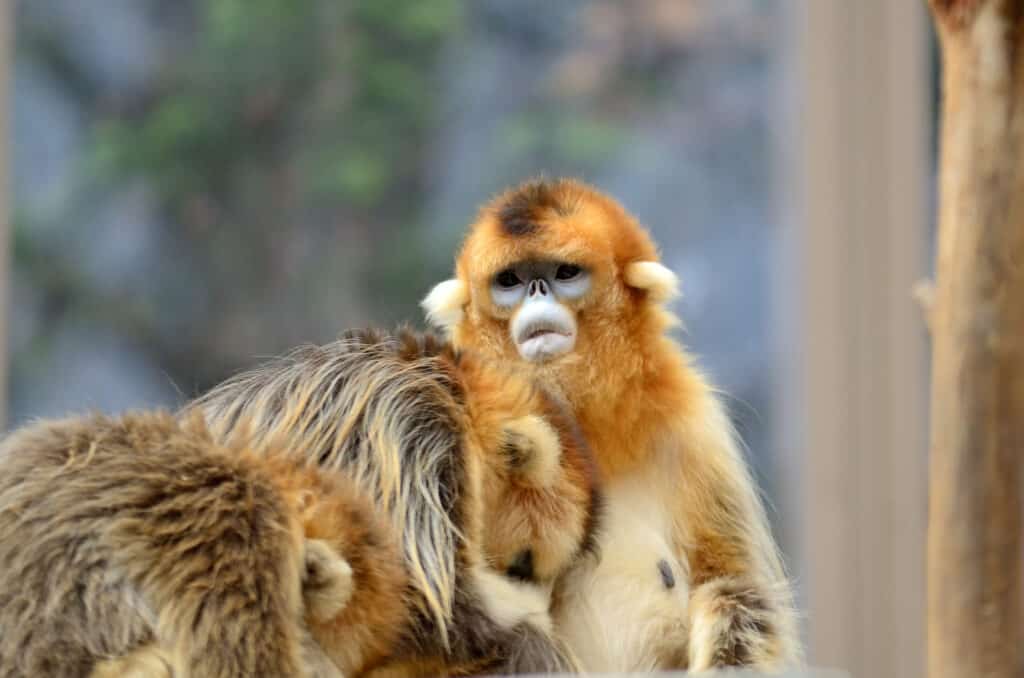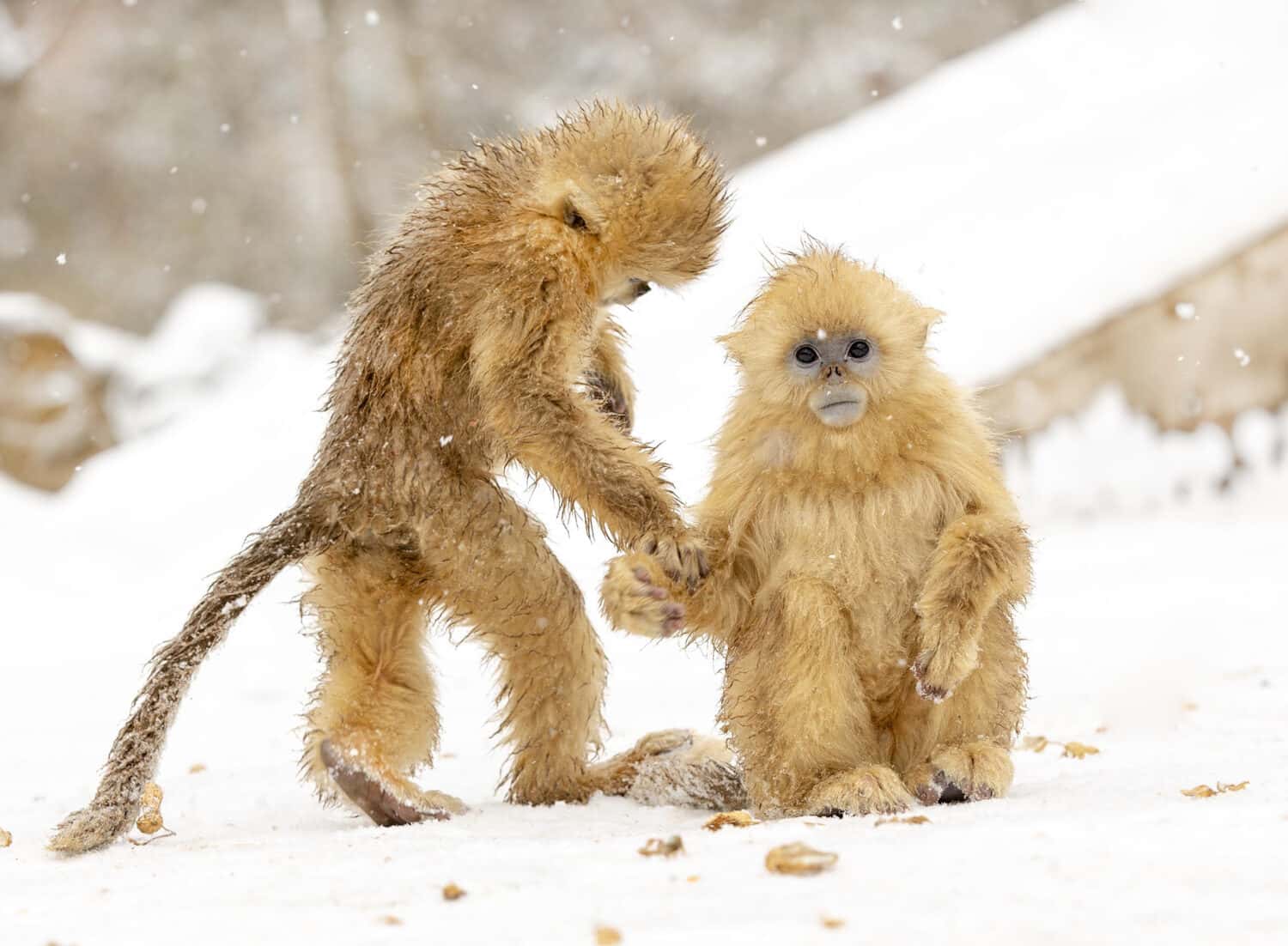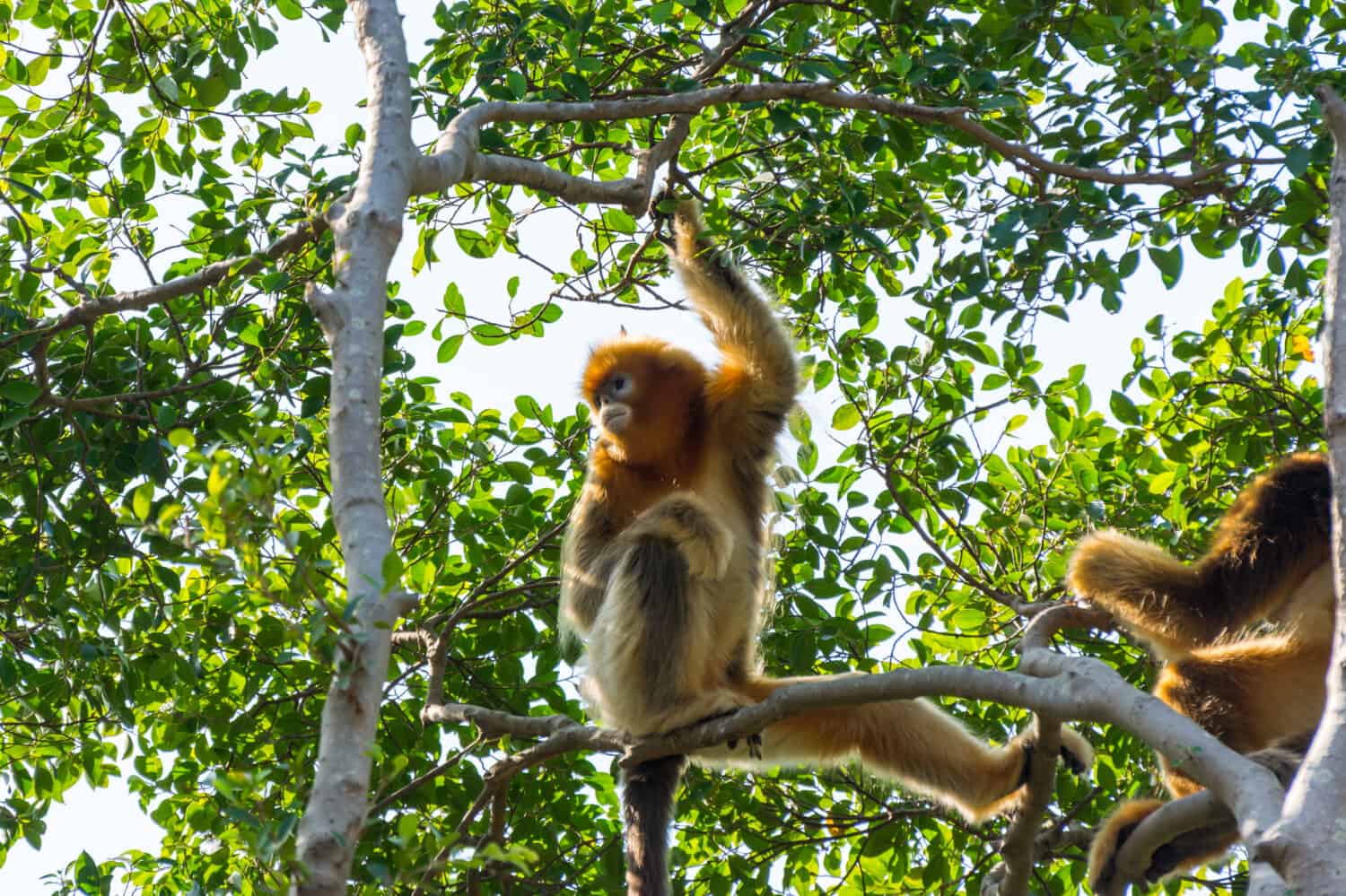There are many fascinating primate species that have obscure and beautiful adaptations. The golden snub-nosed monkey is one such species. These incredible creatures have one-of-a-kind noses and beautiful fur that certainly adds to their intrigue. Come meet the golden snub-nosed monkeys and learn all about their biology, habitat, conservation, and more!
Description

Golden snub-nosed monkeys are known for their unique noses.
©iStock.com/Cn0ra
Golden snub-nosed monkeys (Rhinopithecus roxellana) are captivating and distinctive primates known for their unique physical characteristics. Their most prominent feature is their vibrant golden-orange fur, which serves as excellent camouflage in their dense, high-altitude forest habitats. This luxurious coat provides them with warmth and protection against the cold temperatures in the mountainous regions they inhabit.
In addition, these monkeys exhibit sexual dimorphism, which means that males and females differ in certain physical traits. Typically, males are larger and heavier than females. On average, male golden snub-nosed monkeys weigh 47 pounds. Females are somewhat smaller, with an average weight of around 27 pounds. Golden snub-nosed monkeys do not possess prehensile tails like some New World monkeys. Their tails are typically 17 to 24 inches and are not adapted for grasping or hanging from branches. Instead, they primarily rely on their strong limbs and dexterous hands for locomotion and foraging in their arboreal environment. These monkeys are well-adapted to their challenging mountainous habitats, where they navigate steep terrain, leaping between trees and scaling cliffs with agility. Their unique snub-nosed facial features and distinctive fur color make them a fascinating and visually striking species within the primate world
Taxonomy
The golden snub-nosed monkey belongs to the class Mammalia, which encompasses all mammals, including humans. Within the order Primates, they are classified under the family Cercopithecidae, the same family as Old World monkeys. This family includes a wide range of monkey species distributed across Africa and Asia.
Species and Subspecies
The genus Rhinopithecus is a unique one within the Old World monkey family. The golden snub-nosed monkeys are further classified into several species and subspecies:
- Rhinopithecus roxellana roxellana: This is the nominate subspecies, often referred to simply as the golden snub-nosed monkey.
- Rhinopithecus roxellana qinlingensis: This subspecies lives in the Qinling Mountains, just like the nominate subspecies, but they have some distinct morphological and genetic differences.
- Rhinopithecus roxellana hubeiensis: This is another similar mountain-dwelling subspecies in China.
Evolutionary Relationships

Rhesus macaques are Old World monkeys, just like golden snub-nosed monkeys.
©Blueton/Shutterstock.com
In terms of their evolutionary relationships, golden snub-nosed monkeys are more closely related to other Old World monkeys, such as macaques, than to apes, including humans. Apes and humans belong to the family Hominidae and the superfamily Hominoidea, which is distinct from the Cercopithecidae family. The genetic divergence between Old World monkeys and hominids, including apes and humans, occurred millions of years ago, indicating a significant separation in evolutionary history. While we share a common ancestor with all primates, the golden snub-nosed monkey’s lineage branched off from ours long before the emergence of the human and ape lineages.
Biology
Diet

Golden snub-nosed monkeys are arboreal and herbivorous.
©Simon Chenfs/Shutterstock.com
Golden snub-nosed monkeys are primarily herbivorous. Therefore, they rely on leaves, fruits, bark, and various plant materials. Their digestive system has evolved to efficiently extract nutrients from fibrous plant matter. They have a complex stomach with multiple chambers that aid in the fermentation and digestion of tough plant cellulose. In fact, this adaptation allows them to extract more energy from their plant-based diet. This is essential for survival in their resource-scarce mountain habitats.
Mating and Reproduction

These adorable infant golden snub-nosed monkeys are usually born between March and June.
©Wang LiQiang/Shutterstock.com
Golden snub-nosed monkeys typically exhibit a polygynous mating system. This is where a single dominant male mates with multiple females within a social group. These monkeys live in multi-male, multi-female groups, with the dominant male having exclusive access to mating opportunities. This social structure often leads to competition among males for the coveted position of the alpha male within the group.
Golden snub-nosed monkeys have a relatively slow reproductive rate. Females give birth to a single offspring after a gestation period of about 200 to 215 days. Births usually occur in the spring or early summer when food resources are more abundant. Infant monkeys are dependent on their mothers for several months and will wean after about a year. The extended maternal care and slow reproductive rate contribute to the conservation challenges this species faces. As a result, it makes the monkeys more vulnerable to population declines.
Early Development
Golden snub-nosed monkeys undergo fascinating early development. They are born with a dark coat, but as they age, their coat lightens, and their nose turns golden, hence the name. These monkeys are highly social and live in tight-knit groups, with infants receiving constant attention and care from their mothers and other group members. Early development includes learning crucial social skills, foraging techniques, and adapting to the challenging mountainous terrain of their habitat in China. The nurturing environment provided by their troop is essential for their survival and long-term success.
Unique Adaptations
The distinctive, upturned noses of golden snub-nosed monkeys have intrigued scientists for years. Evolutionary biologists believe that this unique nasal feature may have evolved as an adaptation to the cold, high-altitude environments they live in. The flattened, upturned nose helps reduce heat loss by minimizing the surface area exposed to the frigid air. This is especially beneficial during the harsh winter months. Additionally, the absence of a protruding nose may reduce the risk of frostbite. This adaptation is an example of how evolution can shape physical traits to enhance an animal’s ability to survive and thrive in its specific ecological niche.
Distribution
Geography
Golden snub-nosed monkeys are endemic to China and only live in a few isolated regions. They primarily inhabit mountainous areas in central and southwestern China. The main regions they occupy include the Qinling Mountains in Shaanxi Province, the Minshan Mountains in Sichuan Province, and the Shennongjia Forest area in Hubei Province. These regions are at high elevations and consist of rugged terrain.
Habitat Preferences

Golden snub-nosed monkeys live in mountainous areas that receive snow in the winter.
©Wang LiQiang/Shutterstock.com
Golden snub-nosed monkeys have special adaptations that allow them to live in temperate, montane forests. They inhabit coniferous and broadleaf mixed forests at elevations ranging from 1,500 to 4,500 meters (4,900 to 14,800 feet) above sea level. These forests are often shrouded in mist and experience cold winters with heavy snowfall. Luckily, the monkeys are well-suited to these environments. Their thick fur and specialized digestion allow them to cope with low temperatures and a diet of fibrous plant materials.
Troop Size
Golden snub-nosed monkeys live in complex social structures. Their multi-male, multi-female groups can range in size from a dozen individuals to over a hundred. These troops are hierarchical, with a dominant male leading the group and several females and their offspring. Subordinate males also reside within the troop but have fewer mating opportunities.
The size of the home range for a troop of golden snub-nosed monkeys can vary. Various factors influence home range size like food availability and population density. Their home ranges can span from several square kilometers to tens of square kilometers. These monkeys move seasonally within their home ranges in search of food, migrating to higher elevations during the summer and descending to lower elevations in the winter to escape the deep snow and find more accessible food sources.
Conservation

One of the threats these monkeys face is habitat destruction.
©Victor Jiang/Shutterstock.com
According to a 2020 revision of the IUCN Red List population assessment of golden snub-nosed monkeys, this species is endangered and experiencing a decreasing population trend.
Conservation efforts to protect golden snub-nosed monkeys have become increasingly important due to their limited distribution and vulnerability to various threats. Several initiatives and strategies have been implemented to help safeguard these unique primates:
Scientific Efforts
1. Research and Monitoring: Ongoing scientific research and monitoring programs are essential for understanding the population dynamics, behavior, and ecological needs of these monkeys. Researchers collect data on group size, reproduction rates, and habitat use to inform conservation strategies.
2. Habitat Restoration: Secondly, efforts to restore and protect the monkeys’ habitat are vital. Reforestation projects and habitat restoration initiatives help to maintain the integrity of the forests and provide a sustainable environment for the monkeys to live and find food.
3. Translocation and Reintroduction: In some cases, translocation and reintroduction programs attempt to establish new populations of golden snub-nosed monkeys in suitable habitats outside their current range. However, this approach requires careful planning and monitoring to ensure the success of reintroduced populations.
Social and Political Efforts
1. Protected Areas: Firstly, establishing and managing protected areas and national parks within the monkeys’ natural range is a fundamental conservation measure. These areas provide a sanctuary where hunting and habitat destruction are restricted or prohibited. Notable protected areas include the Shennongjia Nature Reserve and the Foping National Nature Reserve in China, which are crucial for the conservation of golden snub-nosed monkeys.
2. Anti-Poaching Measures: Also, to combat illegal hunting and poaching of golden snub-nosed monkeys for their fur or as bushmeat, anti-poaching laws, and wildlife law enforcement are established and strengthened. These efforts include patrolling, confiscating illegal wildlife products, and educating local communities about the importance of protecting these primates.
3. Education and Awareness: Public awareness campaigns and educational programs inform local communities, as well as the wider public, about the significance of golden snub-nosed monkeys in the ecosystem and the importance of conserving them. These campaigns often include school programs, workshops, and outreach activities.
4. Translocation and Reintroduction: In some cases, translocation and reintroduction programs are considered to establish new populations of golden snub-nosed monkeys in suitable habitats outside their current range. However, this approach requires careful planning and monitoring to ensure the success of reintroduced populations.
5. International Cooperation: Finally, collaboration between countries and international conservation organizations is crucial for protecting golden snub-nosed monkeys. Joint efforts help in sharing knowledge, expertise, and resources to address the various challenges they face.
Conservation of golden snub-nosed monkeys is not only essential for the survival of this remarkable species but also for maintaining the health and biodiversity of their unique montane ecosystems. Continued dedication to these conservation efforts is essential to ensure the long-term survival of these endangered primates in the wild.
The photo featured at the top of this post is © V_E/Shutterstock.com
Thank you for reading! Have some feedback for us? Contact the AZ Animals editorial team.






